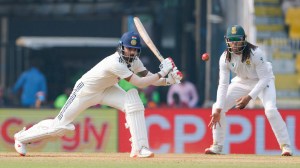May Day, 1923: When India celebrated its first Labour Day
Introducing the country to the concept of Labour Day, Singaravelar presided over two meetings in Chennai. Explaining the significance of his party, and the labour movement in general, Singaravelar called for May 1 to be declared a holiday.
 Explaining the significance of his party, and the labour movement in general, Singaravelar called for May 1 to be declared a holiday. (Photo used for representational purpose/ Express Photo by Javed Raja. )
Explaining the significance of his party, and the labour movement in general, Singaravelar called for May 1 to be declared a holiday. (Photo used for representational purpose/ Express Photo by Javed Raja. )
The second decade of the twentieth century was a time of extraordinary political activity in the country. The Gandhian mode of nationalist struggle had taken off and the Communist movement too was marking its initial presence in the country. It was during this period, on May 1, 1923, that prominent Communist leader Malayapuram Singaravelu Chettiar raised the red flag in Chennai. This was the first time in India’s history that the flag was raised. In the ensuing century, it would go on to symbolise Communism in India. But this was also the moment when the country was introduced to May Day celebrations.
May 1 had a symbolic value attached to it by every follower of Communism in the world. The date was associated with the voice of a thriving labour movement across the globe, that was eager to preside over the dominating class. It was chosen as the date for celebrating International Workers’ Day in 1886, as a means to mark the Haymarket Affair in Chicago, which was a labour demonstration that took place in reaction to an incident of the police inflicting brutality on several workers. Over the years, the date held huge significance to communism in most countries, particularly in China, North Korea, Cuba and the Soviet Union.
 May 1 was chosen as the date for celebrating International Workers’ Day in 1886, as a means to mark the Haymarket Affair in Chicago. (Wikimedia Commons)
May 1 was chosen as the date for celebrating International Workers’ Day in 1886, as a means to mark the Haymarket Affair in Chicago. (Wikimedia Commons)
In India, the Communist struggle had taken birth in the midst of the nationalist movement and was in fact deeply connected to it as well. Singaravelar was a staunch Gandhian before he became part of the Communist movement. On May 1, 1923, when he raised the red flag for the first time, he also founded his own party- The Labour Kisan Party of Hindustan. Introducing the country to the concept of Labour Day, Singaravelar presided over two meetings in Chennai- one at the beach opposite Madras High Court, and the other at Triplicane beach. Explaining the significance of his party, and the labour movement in general, Singaravelar called for May 1 to be declared a holiday.
“The president of the party explained the non-violent principles of the party. There was a request for financial aid. It was emphasised that workers of the world must unite to achieve independence,” reported the Hindu from the event. Singaravelar also announced that his party would be working closely with the Congress, functioning as its labourer and farmers’ wing.
Though his party died out in the next two years, the country has continued to celebrate May Day as a means to honour the effort put in by workers. More than 80 countries across the world observe the day as a national holiday.



- 01
- 02
- 03
- 04
- 05




























